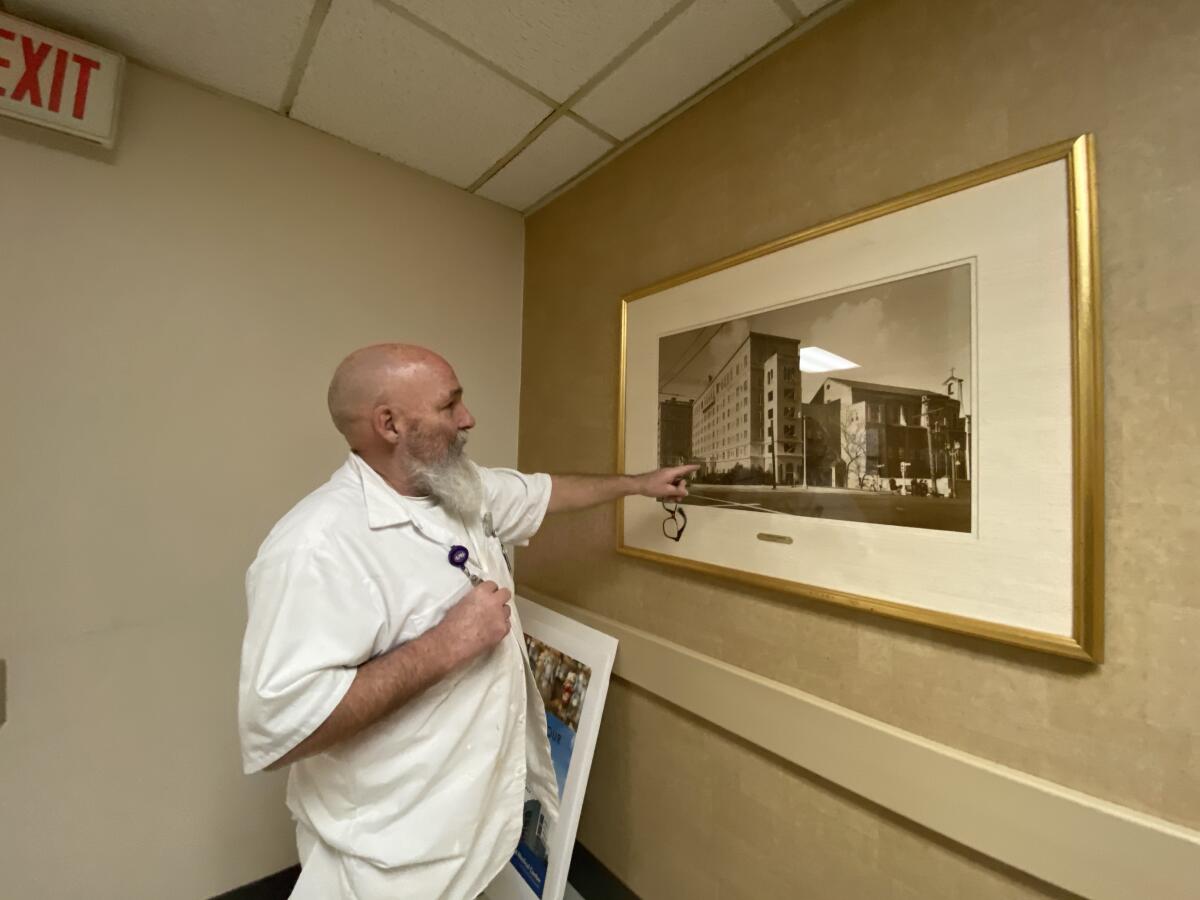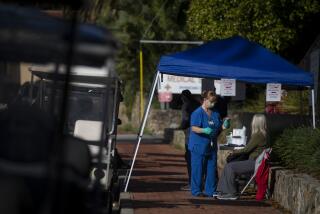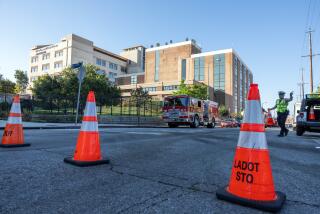After years of financial woes, Los Angeles hospital running out of prayers
Many years ago, Gilbert San Juan watched as a wrecking ball demolished the old St. Vincent Medical Center.
An elevator operator and painter there at the time, San Juan wanted to fetch some old furniture from the building, but backed down after seeing the massive, threatening ball hanging from a crane.
Still, he knew he would enter its doors again, when the new hospital near downtown Los Angeles sprung just yards away from the old. For 47 years, San Juan worked in that facility.
So it hasn’t quite hit him that the hospital might actually shutter for good after its owners announced that a sale fell through, he said. Verity Health asked a bankruptcy court for permission to close its doors. A judge gave approval for the closure last week.
“They’re going to have to call the SWAT team to get me out of here,” San Juan joked as he walked through the hospital hallways.
Pointing at a sepia-toned framed photograph of the old building labeled “1927,” San Juan declared: “It was beautiful.”
St. Vincent Medical Center on 3rd and Alvarado streets was founded in 1858 by the Daughters of Charity — six nuns who wanted to offer services to the poor and saw a need for healthcare in a growing L.A.
Now, several hundred patients will need to be transferred to nearby Good Samaritan Hospital and St. Francis Medical Center. Community leaders and experts fear the hospital’s closing will have a ripple effect throughout the community and force the poor and elderly to travel farther away for care.
About 1,000 people, including San Juan, work at the hospital and it is unclear what will happen to those jobs.
Throughout the decades, the mission of the hospital to serve the most needy remained consistent. St Vincent Medical Center’s “disproportionate share percentage” is 70%, which means it serves mostly low-income patients who rely on Medicare and Medicaid, said John Romley, associate professor of pharmaceutical and health economics at USC.
The hospital leans heavily on Medicaid and Medicare, which reimburses the hospital at lower rates than commercial insurance, according to experts. It sits in a working-class, predominantly Latino neighborhood with large Mexican and Central American immigrant populations.
The hospital’s community work had decreased over the years as its financial problems worsened, but it had a history of working with organizations such as the Central American Resource Center, or CARECEN, to offer health screenings and general checkups for free to the area’s immigrant and day laborer communities.
“Having institutions that are anchored in a community such as Westlake and Pico Union are critical to the continued growth and strength of an area,” said CARECEN’s executive director Martha Arevalo. “When we lose those anchors, that has a tremendous ripple effect.”
In its early days, the Daughters of Charity offered care for $1.50 per day to the working class: fishermen, shop owners, stable keepers and watchmakers. Doctors treated pneumonia, typhoid and malaria they said was brought by “newcomers, not wearing sufficiently heavy clothing, particularly in the evening,” according to a Los Angeles Times article in 1887.
According to its website, doctors at St. Vincent Medical Center would later become the first to perform an open heart surgery on the West Coast, the first to offer hemodialysis to kidney failure patients, the first to perform an artificial heart implant and the first to perform a human heart transplantation.

As L.A. prospered, so did the hospital. An 1885 article in The Times boasted of the hospital’s views of the city and far-off orange groves and vineyards from its sparkling new building on Beaudry and Sunset: “The valley can be seen for from thirty to forty miles south and east, and on clear days the ocean plainly appears.
“As a public institution, it is without an equal south of San Francisco,” the article read.
But financial woes soon trailed the hospital.
The Daughters of Charity racked up debt to construct new facilities. When the hospital moved to its current location on Third and Alvarado in the 1920s, one Times article noted the nuns were “unable to accumulate the capital to defray the cost of the institution” due to the thousands of patients who received care “without the payment of even a moderate fee.”
In recent years, the hospital had changed ownership several times, though that’s not unusual in today’s market-driven healthcare landscape, according to experts.
Among the creditors in the bankruptcy is the hospital system’s former management company, Integrity Healthcare, controlled by entrepreneur-physician Patrick Soon-Shiong’s company NantWorks. Soon-Shiong also owns The Times.
Verity, the nonprofit operator of six California hospitals, filed for bankruptcy protection in 2018. At the time, officials said the company had more than $1 billion of debt from bonds and unfunded pension liabilities and needed cash to make seismic repairs to its aging facilities. They said they’d purchased the hospitals in 2017 hoping to get back to financial health but could not.
The bankruptcy sparked concerns in communities about the fate of the hospitals. Santa Clara County has taken over operations of two of the hospitals — O’Connor Hospital in San Jose and St. Louise Regional Hospital in Gilroy. The move came after the California attorney general demanded oversight of the transfer.
St. Francis Medical Center in Lynwood has also been the subject of debate, because of its importance to the southeast Los Angeles County region. Lynwood officials last year even discussed purchasing the medical center.
Verity said last week it would continue operating St. Francis as well as Seton Medical Center and Seton Coastside in San Mateo County.
St. Vincent Medical Center (which is not related to the New York health system of the same name) is home to the Asian Pacific Liver Center, which focuses on Hepatitis B awareness, screenings and care for the Asian American population, which is disproportionately affected by the disease.
The hospital’s volunteer department has for years supported operations and deployed people to participate in organizations such as Meals on Wheels.
Through a spokeswoman, Verity Health declined to allow longtime staff members and heads of these organizations to speak to a Times reporter.
St. Vincent’s isn’t the only hospital to face financial challenges. There has been much variability in the healthcare industry in terms of ownership changes and mergers, Romley said. Between 25% and 30% of all California hospitals are operating at a loss. St. Vincent Medical Center, lost $67 million in 2018, he said.
“This organization has been in some turmoil for some time,” Romley said. “It’s been heading in this direction for a while.”
It’s the neediest populations that are often more at risk of losing their hospitals. According to a study on trauma centers by UC San Francisco researchers, emergency rooms in hospitals located in low-income neighborhoods are 1.5 times more likely to close and those patients are affected more severely than other areas.
When the Martin Luther King Jr. Hospital closed in 2007, the number of uninsured patients that one local hospital treated tripled from 12.9% in 1999 to 44.6% in 2009, according to a 2016 study co-authored by Renee Hsia, a professor in the Department of Emergency Medicine at UC San Francisco.
When a hospital closes its emergency room and its patients are diverted to the next closest hospital, both the patients being transported and the patients who were already receiving care in the hospital experience higher mortality rates, Hsia said.
She cited a mix of factors, including longer distances patients need to travel to receive care and overcrowded hospitals.
“Peoples’ emergencies don’t go away when an ER closes,” Hsia said. “There is a very real and documented domino effect, especially in areas where there is need.”
“It’s important people realize the supply of hospitals is not regulated,” she added. “Hospitals can decide whether to open and close where and when they want.”
Verity Health has said patients in need of emergency care will be directed to eight hospitals within a three-mile radius of St. Vincent Medical Center, although it didn’t name which hospitals.
Good Samaritan, a 408-bed hospital also in the Westlake neighborhood, has a 70% disproportionate share percentage and lost $8 million in 2018. St. Francis Medical Center, which has 384 beds, did not suffer losses in 2018, but 100% of its patients are low-income.
Teresa Henrique, 75, who has gone to St. Vincent Medical Center for years, said she didn’t know the hospital would be closing.
“I’ll have to find a new hospital,” she said. “I’ll have to see if they’ll take my insurance. They treated me really well at [St. Vincent Medical Center]. I like it.”
Kay Kim, 65, said she has relied on the hospital for emergency care, for herself, her parents and other family members. It was where both her parents, Korean immigrants, died.
“It’s close to where I live,” she said. “Whenever I have an emergency, I come here. I hope someone else buys it. That’s very sad.”
At the hospital’s “Cafe on 3rd” last week, employees whispered about the closure. A maintenance supervisor tapping on his phone announced he was being ordered to redo the coverings for the emergency room signage.
“We leave the 24th,” said one woman in the hospital’s cafe. “Well be the last ones out.”
“Que tristeza,” a cafe employee told colleagues in Spanish. What a shame.
One employee fretted about being without work for an extended time.
Carlos Bueno, the maintenance supervisor, said his company will stay behind after the hospital’s closure, but some co-workers are already tweaking their resumes.
As he covered signs around the hospital, he saw staff members congregate in groups taking photos. For the memories, he guessed.
Elpidio Villaneda, who in March would have reached his 30-year work anniversary at the hospital, said it has been his second home.
“I thought the city or something would jump in,” Villaneda said. “It’s a landmark, you know? We could use another hospital. There’s enough people here to support it.”
“Everybody is sad, everybody is down right now,” Bueno said.
Huddled around a cafe table, San Juan took out his phone to play a song, “Todo Tiene Su Final.”
“Like Willie Colon and Hector Lavoe say, everything comes to its end,” San Juan said.
More to Read
Start your day right
Sign up for Essential California for news, features and recommendations from the L.A. Times and beyond in your inbox six days a week.
You may occasionally receive promotional content from the Los Angeles Times.







